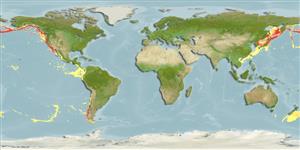Common names from other countries
>
Perciformes/Zoarcoidei (Eelpouts and pricklebacks) >
Zoarcidae (Eelpouts) > Lycodinae
Etymology: Bothrocara: Greek, bostrykos = cure of lack of hair + Tupí, guaraní, acará = the name of a fish. It could be also from Greek, kara = face (Ref. 45335).
More on author: Bean.
Environment: milieu / climate zone / depth range / distribution range
Écologie
marin bathydémersal; profondeur 129 - 2570 m (Ref. 50550), usually 457 - ? m (Ref. 2850). Deep-water
North Pacific: Sakhalin, Russia and Navarin Canyon in the Bering Sea to Attu Island in the Aleutian chain and Coronado Islands, Baja California, Mexico.
Taille / Poids / Âge
Maturity: Lm ? range ? - ? cm
Max length : 74.0 cm TL mâle / non sexé; (Ref. 80637)
Description synthétique
Clés d'identification | Morphologie | Morphométrie
Épines dorsales (Total) : 0; Rayons mous dorsaux (Total) : 100 - 112; Épines anales: 0; Rayons mous anaux: 95 - 100. Dorsal and anal fins enveloped anteriorly in soft gelatinous tissue (Ref. 6885). Uniform light gray or brown, semi translucent, blue or black margins on dorsal and anal fins; color stronger posteriorly, transparent on narrow margins of unpaired fins; light on lining on mouth; black on peritoneum (Ref. 6885).
Found on mud or sandy-mud bottoms (Ref. 2850). The stomach contents indicate that it feeds upon a wide variety of bottom-dwelling organisms, probably eating anything it encounters that has food value and is small enough to ingest (Ref. 4525).
Life cycle and mating behavior
Maturities | Reproduction | Spawnings | Egg(s) | Fecundities | Larves
Eschmeyer, W.N., E.S. Herald and H. Hammann, 1983. A field guide to Pacific coast fishes of North America. Boston (MA, USA): Houghton Mifflin Company. xii+336 p. (Ref. 2850)
Statut dans la liste rouge de l'IUCN (Ref. 130435)
CITES (Ref. 128078)
Not Evaluated
Menace pour l'homme
Harmless
Utilisations par l'homme
Outils
Articles particuliers
Télécharger en XML
Sources Internet
Estimates based on models
Preferred temperature (Ref.
115969): 0.2 - 4.8, mean 2.6 (based on 298 cells).
Phylogenetic diversity index (Ref.
82804): PD
50 = 0.5039 [Uniqueness, from 0.5 = low to 2.0 = high].
Bayesian length-weight: a=0.00186 (0.00113 - 0.00307), b=3.25 (3.10 - 3.40), in cm Total Length, based on LWR estimates for this species & (Sub)family-body (Ref.
93245).
Niveau trophique (Ref.
69278): 3.6 ±0.0 se; based on diet studies.
Résilience (Ref.
120179): Milieu, temps minimum de doublement de population : 1,4 à 4,4 années (Fec=1,650-2,480).
Fishing Vulnerability (Ref.
59153): Moderate to high vulnerability (50 of 100).
